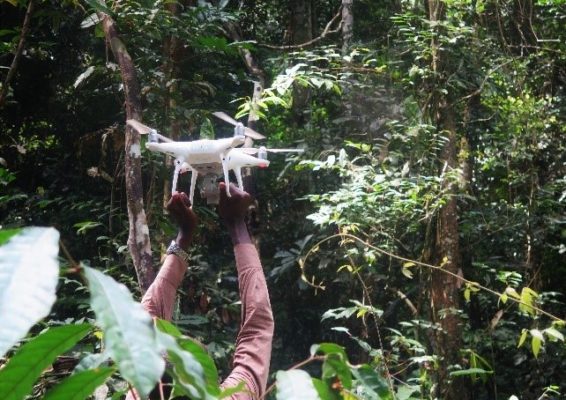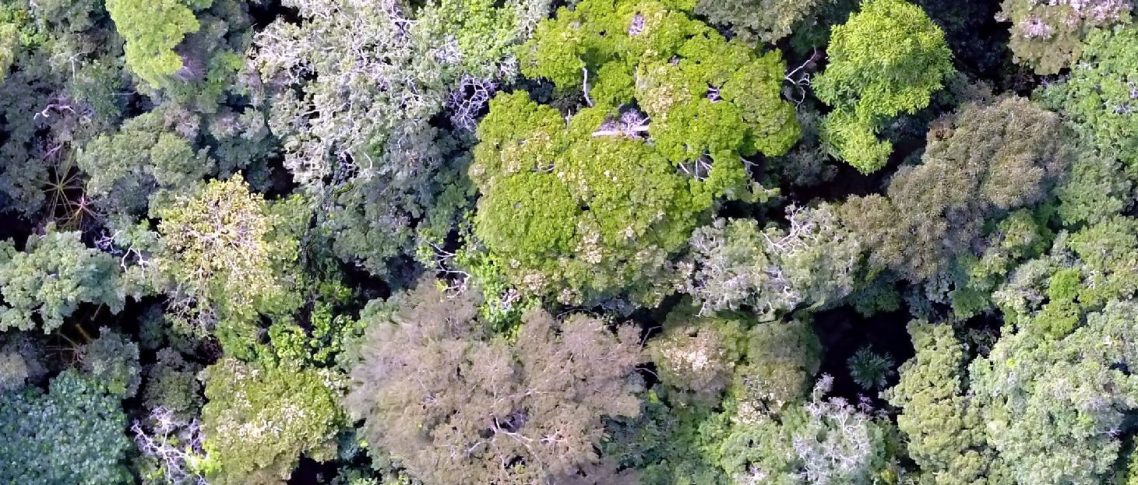Studying the dense and humid forests of the Congo Basin is no mean feat. Under rustling tree canopies, buttress roots tangle with climbing plants to form natural barriers, murky creeks cut across muddy and narrow paths, and the scorching heat and humidity fill the air with steam. Foresters have to hike for hours and even days in these conditions to get as close as possible to their subject of study.
The challenge is even bigger when the research in question requires measuring the crowns of huge tropical trees, some of them up to 60 meters high. Until recently, scientists had to estimate crown dimensions based on the shadows projected by trees, but in tropical rainforests trees are surrounded by thick vegetation and uneven ground, so the process was tiresome and the results somewhat imprecise.
Now, new remote sensing technologies such as satellites and drones are offering unprecedented opportunities for scientists to get closer than ever to the canopy, without even setting foot in the forest.
These innovations are revolutionizing tropical forestry, according to Jean-Baptiste Ndamiyehe Ncutirakiza, a 29-year-old Ph.D. student from the Democratic Republic of Congo (DRC), who says the drones are a powerful tool to characterize the structure and dynamics of Central Africa’s forests.
“The Congo Basin remains the world’s least-known forest, but remote sensing is shaking things up,” said Ndamiyehe. “We are now able to collect data in difficult access areas, sometimes much faster and cheaper than working on the ground, and without disturbing nature.”
Crowns matter
One of the research tasks that has significantly been eased with the use of remote sensing is crown measuring, explained Ndamiyehe. “We can now obtain tree crown dimensions and tree growth estimates using high resolution aerial imagery that are much more accurate than ground-based measurements.”
Accurate crown size data can significantly improve biomass calculations, which are crucial to understanding carbon stocks and guiding forest management decisions, according to Ndamiyehe.
The Congo Basin plays a vital role as a carbon sink, absorbing carbon, which helps mitigate climate change. Yet existing carbon stock calculations remain imprecise – a pressing challenge for experts calling for nature-based solutions to climate change.
Up to now, most researchers estimate carbon stocks by calculating the diameter of trees, wood density and height, but crown size and structure also play a role, which has until now remained understudied due to the difficulties of doing research from the ground.
Quantifying tree crown attributes by remote sensing can be an important contribution to filling the information gap on tree crown – their relative growth in relation to overall tree growth – according to Ndamiyehe. “We can also better understand tree growth trajectories for many coexisting species in the Congo Basin with positive implications for improving current and future biomass estimates,” he said.
An advantage is that both governments and private companies can use allometries to estimate biomass to improve forest inventories, a key step towards more sustainable forest management. In turn, the entire management process and forest governance frameworks gain benefits, and data verification is simplified.


Drones to the rescue
Ndamiyehe uses drones for his research because, he says, they present interesting advantages compared to other remote sensing technologies such as LiDAR and satellite.
Indeed, drones are relatively cheap and easy to use, and – extremely relevant for “rainforests” – they can fly under the clouds, a major obstacle for other types of images. They also offer high spatial resolution images of the order of centimeter per pixel.
Although the technology cannot capture aerial images of all trees in the forest, it can document those that are most important. For example, a recent study by Ndamiyehe identified and photographed 23% of trees in a demonstration plot in the DRC’s Yoko Forest Reserve, but because these trees were the biggest, the study estimates that they contain around 75% of total biomass in the area.
These results show that is now possible to accurately map biomass at the tree level in a forest – a crucial step towards increasing large-scale carbon stock estimates. Ndamiyehe also found that measurements on the ground and those extracted from aerial images related to crown size were complementary and provided equal information for estimating the diameter growth of trees.
Such results, which Ndamiyehe says would be interesting to test in other forests, are likely to revolutionize the way forest resources are quantified, reducing dependence on the use of field inventory data.
Foresters of the future
Ndamiyehe, whose Ph.D. research is jointly directed by scientists from Gembloux Agro-Bio Tech, the University of Kisangani (UNIKIS), and the French Center for International Cooperation in Agricultural Research for Development (CIRAD), works with a program sponsored by the project FORETS (Formation, Recherche, et Environnement dans la Tshopo), financed by the European Union and coordinated by the Center for International Forestry Research (CIFOR). One of the objectives of the project is to train the next generation of Congolese forest experts, who can contribute to sustainably manage the country’s vast natural resources.
This entails encouraging students to adopt, test and improve new technologies, according to Paolo Cerutti, a scientist with CIFOR. “Many of the innovations available to forest researchers elsewhere are not yet used in the Congo Basin and they need ad-hoc solutions for this context. These bright young students are rapidly changing this situation.”
Since 2007, CIFOR and the EU have supported more than 220 Ph.D. and master’s students at UNIKIS, who are now promoting better forest management from within government, academic and private sectors.
We want you to share Forests News content, which is licensed under Creative Commons Attribution-NonCommercial-ShareAlike 4.0 International (CC BY-NC-SA 4.0). This means you are free to redistribute our material for non-commercial purposes. All we ask is that you give Forests News appropriate credit and link to the original Forests News content, indicate if changes were made, and distribute your contributions under the same Creative Commons license. You must notify Forests News if you repost, reprint or reuse our materials by contacting forestsnews@cifor-icraf.org.
